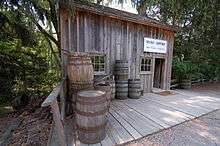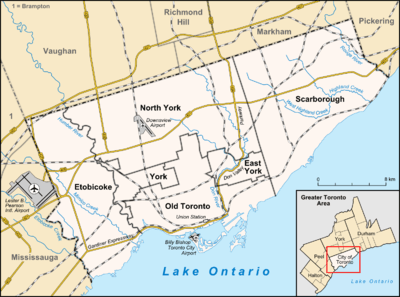Black Creek Pioneer Village
 | |
 Location of the museum in Toronto | |
| Established | 1960 |
|---|---|
| Location | Toronto, Ontario, Canada |
| Coordinates | 43°46′26″N 79°31′02″W / 43.77389°N 79.51722°W |
| Type | Historic site |
| Owner | Toronto and Region Conservation Authority |
| Public transit access |
|
| Website |
www |
Black Creek Pioneer Village, previously Dalziel Pioneer Park,[1] is an open-air heritage museum in Toronto, Ontario, Canada, just west of York University and southeast of the Jane and Steeles intersection.[2] It overlooks Black Creek, a tributary of the Humber River. The village is a recreation of life in 19th-century Ontario and gives an idea how rural Ontario might have looked in the early-to-mid-19th century. The village is a regular destination for field trips by schoolchildren from the Greater Toronto Area. It was opened in 1960 and is operated by the Toronto and Region Conservation Authority.[3]
B. Napier Simpson, Jr. 1925-1978, a restoration architect in Ontario devoted his professional life to raising public awareness of the importance of heritage conservation including the Black Creek Pioneer Village project.[4]
Collection
The pioneer village consists of over forty 19th century buildings, decorated in the style of the 1860s with period furnishings. It is operated by historical interpreters and craftspeople housed in the restored buildings. The site also features historical re-enactments and visiting artisans. Buildings include Dalziel barn, period houses, the original Stong Family farm buildings, a water-powered grist mill, a general store, a blacksmith's shop along with over 10 other trades buildings, a hotel, a church, and a one-room schoolhouse. A core of buildings built by the Stong family are on their original sites, while others have been moved in from across Southern Ontario.
The majority of the buildings were moved from their original sites (notably the large Halfway House and Mennonite Meeting House), and some re-built on their current locations. The board and batten blacksmith shop was originally built in the 1850s in Nobleton.[5] The gunsmith shop was built in Bolton, and the Taylor Cooperage building was built in the 1850s in Paris.[5] The weaver shop is within what was originally a Temperance Hall built in Kettleby in 1850 by the Sons of Temperance.[5]
Affiliations
The Museum is affiliated with: CMA, CHIN, and Virtual Museum of Canada.
See also
References
- ↑ McGee, Nancy Lynn (2013). "Toronto and Region Conservation Authority: Advancing the Sustainability Agenda". In McKeown, Rosalyn; Nolet, Victor. Schooling for Sustainable Development in Canada and the United States. Dordrecht: Springer Netherlands. pp. 223–234. doi:10.1007/978-94-007-4273-4_16. ISBN 978-94-007-4273-4.
- ↑ "TTC names new subway station for Black Creek Pioneer Village". Toronto Star. 2012-07-17. Retrieved 2012-09-28.
- ↑ "History". Black Creek Pioneer Village. Toronto and Region Conservation Authority. 2011. Retrieved 2012-04-08.
- ↑ "Plaque Information - B. Napier Simpson, Jr. 1925-1978". Online Plaque Guide. Ontario Heritage Trust. Retrieved 2012-04-08.
- 1 2 3 Mika, Mike; Mika, Helma; Thompson, Gary (2000). Black Creek Pioneer Village: Toronto's Living History Village. Dundurn. ISBN 1896219640.
External links
| Wikimedia Commons has media related to Black Creek Pioneer Village. |